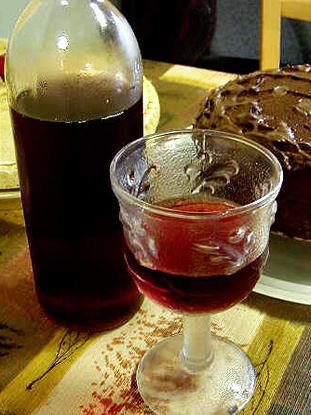
In our search for a more self-sustaining lifestyle, we are changing the way that we shop for food, grow our food and prepare our food. Organic has become the byword for a healthier choice. Why not include wine in the journey to be more organic? The stores are full of wines from all over the world, yet few of them are made without chemicals. One would think, with all the problems and allergies to sulpha, that someone would start making organic wine for sale, somewhere. I am sure they would charge an arm and a leg for it, however.
The reason for high organic cost is shelf life and reliability. Each bottle of “Chablis” from a winery must taste exactly like every other bottle of “Chablis” from that same winery. In addition, customers want the wine to last a long time, even after opening. Would you keep a bottle of fruit juice in the refrigerator for a month and expect it to still be fresh and good to drink after opening? If you could do that, wouldn’t you wonder if it were real food or not? So it is with wine. The sulphite and sorbate keep it from spoiling. The chemicals keep the wines from changing and oxidizing, and kill any foreign, wild yeasts that might help with the process. Are the chemicals and preservatives required to make a good wine? The simple answer is not necessarily–not if you are careful and not if cleanliness and sterility are your first priorities when making your wine.
Basically, wine is the end result of a living yeast growing and multiplying in organic juice with sugar added. The yeast feeds on the sugars in the juice and produces alcohol and carbon dioxide. When the sugar has all been used up or the alcohol content has reached an amount that kills the yeast (about 12% usually) the wine is finished.
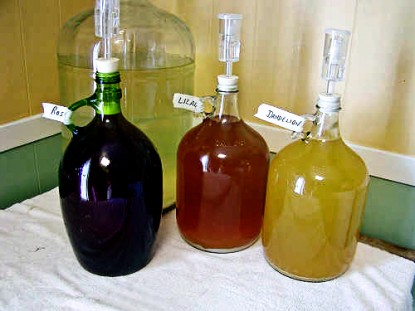
While you can drink wine as soon as it is finished and it won’t hurt you, it won’t taste very good. It gets much better and mellower with time. Most organic wines are much better after aging for a year. Some can be used in about 6 months, but are better after a year. Some, like dandelion, get better after two years. A wine can taste like paint thinner at six months and be the best wine you have ever tasted in your life after aging for a year.
There are some things that I add to my wine to help the yeast and to make a better wine, but they are all organic. I add pectic enzyme to eat up the pectin in the juice so the wine will be clear and I add a commercial acid blend. You can just use lemon or orange juice and I have many recipes that do just that, but I prefer to keep it simple and just use the blend of malic, tartaric and citric acids mixed commercially for winemaking. Some recipes call for tannin, if there is not enough in the juice naturally. I don’t always add it but when I do, it’s in the form of a green tea bag or two.
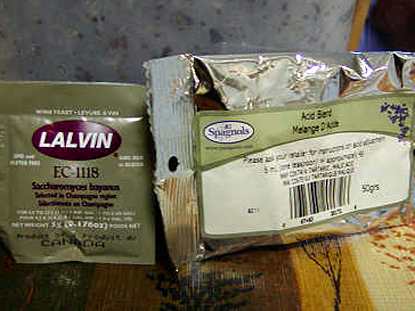
I have formulated most of my own recipes for making wine from the many different types of organic juice bases. None of them contain Camden tablets (sulphite) or sulphite powder or sorbate. Most use acid blend instead of lemon or orange juice, for simplicity.
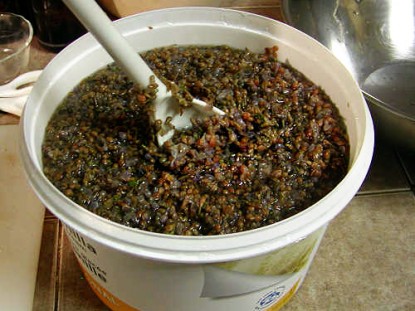
You can be sloppy and just throw it all together and you may still get a good wine. Some people even put the juice outside in the summer in the hopes of capturing wild yeast to aid in the winemaking process. Many times this works, but many times it does not. You can end up with vinegar or a wine you wouldn’t want to drink. If you bake a lot, the baker’s yeast will be flying around your kitchen. Vinegar is made the same way, but with a different yeast and beer is made with yet another yeast. Wine is made with “wine yeast” and champagne is made with “champagne yeast”, giving it a different, yet pleasing, flavor. While all of these drinks will have alcohol and be potable, if you are making wine, it’s wine that you should end up with. To make wine reliably every time, you do need to be careful.
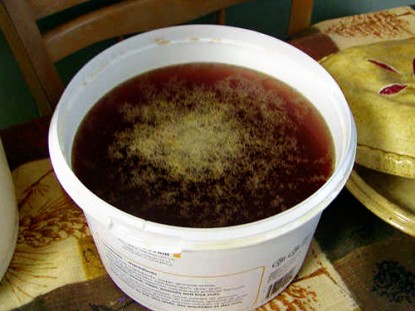
There is a lot of equipment out there that you can use to make wine, but it is not all necessary. Our great-grandfathers made wine all the time and it lasted for hundreds of years, unopened and stored in their cellars. They didn’t use a refractometer or a hydrometer or a thermometer. These things do have a place, especially if you are unsure of yourself or not familiar with growing live yeast, fungus or bacteria in food on purpose in the kitchen, but they are not necessary.
I don’t own a refractometer and have never found a need for one. While I do have a thermometer, I rarely use it for winemaking. I know what lukewarm feels like and wine yeasts are not that particular about temperature, as long as it is not too hot. It will make in the cooler temps, just more slowly. I made a lovely wine this past winter in the fairly cold storage room. It took a lot longer than usual but sometimes that makes a better wine, if you can wait for it! I do have a hydrometer, but don’t always use it. It is possible to make wine without one. You just have to siphon (rack) the wine more often and add a bit of sugar each time until it quits working. You don’t have to add all the sugar up front at once. You can continue to add the sugar as the wine makes, a little at a time, until there is no yeast activity left. You will need an air lock for this, however, so you can watch the gas bubbles escaping to make sure the yeast has finished working before you bottle the wine.
Very Important!! Never bottle the wine until you are absolutely certain the yeast has finished and there will be no more yeast activity in the bottle. In addition to producing alcohol from the sugar, yeast also produces carbon dioxide and it has to go somewhere. If the yeast continues to work in the bottle, the build up of gas will pop the cork or the bottles will explode. (If you want sparkling wine with carbon dioxide in it, you will need to artificially add carbon dioxide to the wine prior to bottling.)
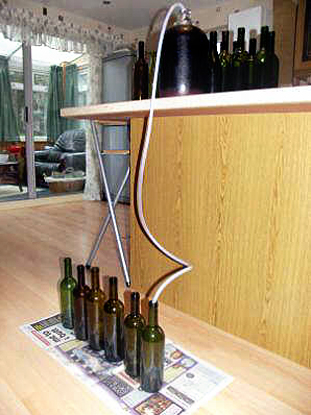
For this reason, I do use the hydrometer most of the time and because I like to check things as they are making. I want to see where it is in the process. This isn’t really good for it, to be opened and exposed to the air, but I’m usually too impatient to leave it alone for weeks at a time. The hydrometer tells me how much sugar is left in it and the possible alcohol content. I have to get in there and check on things, handle things and generally mother it to death, no matter what I am making. This is not necessarily a good trait. I’m certain my kids don’t think so…
There is a lot of basic equipment that you will want to use but if you keep it simple, these things are not hard to find. I use a plastic ice cream bucket and lid to start all my one gallon wines. I apply the KISS (Keep It Simple) principle to everything possible. You can be creative and use all kinds of things to make wine. Even a pickle jar will work, if you can get a bung stopper for it that will hold an air lock.
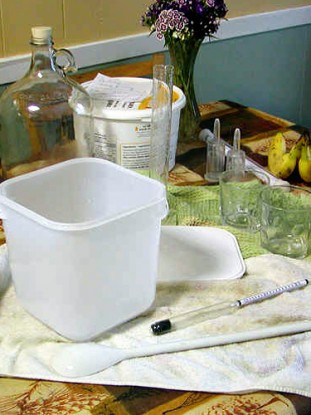
The air lock is one piece of simple equipment that you will need. It lets the gas escape without letting any air in –a unique and simple little device (and cheap!). I don’t know how you would make wine without it, but I’m sure there’s a way. Surely they didn’t use air locks two hundred years ago!

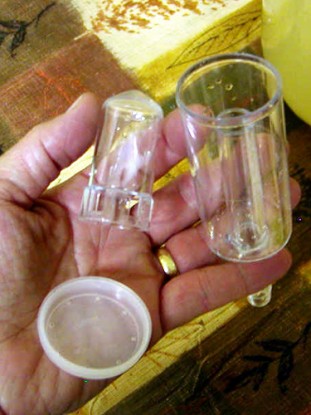
All of this to tell you that you can make your own organic wine at home. It’s really not that hard. Be creative! I have three wines making right now: rose petal, lilac and sugar snap pea pod. I have plans to make wild daylily, bee balm, mint, ground cherry and chichiquelite this year, if time permits.
Use your imagination! Anything that might make a good tea will make a good wine.
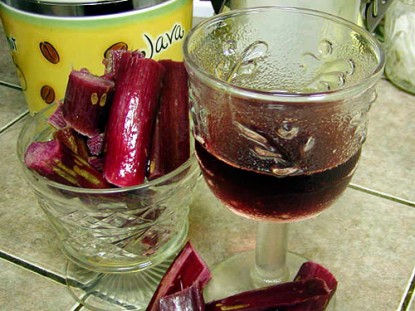
Here is a good starter recipe for a simple apple wine:
12 pounds apples, mixed varieties
2 pounds (not cups) granulated sugar
1 gallon water
1 teaspoon. pectic enzyme
2 teaspoon acid blend
1/2 packet of wine yeast
Quarter the apples and run them through a grinder. Bring pulp to simmer in 1 gallon of water, holding simmer for 15 minutes. Strain juice onto the sugar in primary fermentation vessel, stirring well to dissolve, then reintroduce the strained pulp and, when cool, the pectic enzyme and acid blend, stirring well. Cover, set in a warm place for 24 hours, then add yeast. Cover, and set in a warm place for four days, stirring twice daily. Strain pulp and pour liquor into secondary fermentation vessel and fit with air lock. Rack when clear and fermentation has ceased. Rack again in 30 days and again in another 30 days, then bottle. Allow one year to age.

Get the handy print page and save this to your recipe box here:
Simple Apple Wine.
Editor’s Note: For further information, check out Sheryl’s e-book, Making Organic Wine At Home, available through her farm store.
You can also find Sheryl at Providence Acres.Interested in contributing a guest post to the Farm Bell blog? Read information here for Farm Bell blog submissions.
Want to subscribe to the Farm Bell blog? Go here.



Patrice says:
I might have to try this. We are organic at our house. Wine has recently been a problem for me and I feel certain it is the sulfites. They’re a known asthma trigger. I enjoy wine, but have stopped drinking it because they put the stuff in all commercial wines.
When I was a kid, my dad got into wine making. He wasn’t very good at it and there were always bottles exploding in the basement. He tried homemade air locks-hmm?- didn’t work too well. That corner of the basement is probably still PURPLE today!
On September 4, 2010 at 7:40 am
Sheryl - Runningtrails says:
I wouldn’t make it without an airlock and I use a hydrometer before bottling, just to be sure the max alcohol level has been reached so there will be no more yeast activity in the bottle. I can make it without the hydrometer and have success if careful with the sugar additions. Its just an added safety step. I’ve never had exploding bottles, but my wine is dry. We don’t like it sweet as extra sugar with alcohol will also cause severe headaches.
Some people who want sparkling wine, get the carbon dioxide gas into the bottles by adding a tiny amount of yeast and sugar at bottling time, then corking. Some poeple who make beer do it this way too. You add just enough yeast and sugar to make the gas in the sealed bottles, but not enough to make them explode or pop the corks. Its very tricky and dangerous and you have to be absolutely sure of your amounts. Perhaps this is what your dad did? He may also have added sugar for sweetness when bottling, although the yeast were still active. That would make the bottles explode too.
I would definitely use a hydrometer and make sure the wine had reached max alcohol levels before adding any more sugar to it. Its the only way to make sweet wine without chemicals.
I buy bung and airlock combo from the local small wine place for about $4, basic hydrometer alone for $8. They are not expensive.
On September 4, 2010 at 9:38 am
CindyP says:
I don’t think I would leave it alone either…I have a problem with A.D.D. when it comes to things like this…I like to see gratification to quickly 😉
Excellent post, Sheryl!
On September 4, 2010 at 9:42 am
drucillajoy says:
very, very interesting topic…I have made several batches of wine in the past & it was very good, but it has been quite a few years. I am planning on it this year, as I now have 18 lbs. of elderberries in my freezer…some for pies, most for wine.
My biggest problem will be keeping my 19 yr. old son out of it. Several weeks ago he was talking with some friends & got the bright idea to make wine…it was a very crude process made with fruit, sugar & a slice of bread…all kept in a zip-lock bag…the bag started to leak, then put it in my big tupperware bowl…the lid kept popping off..he kept tasting it…then decided he’d put it in a couple of old wine bottles…corks blew out in the night…then he just left the corks out…then asked me why there was little flies everywhere…meanwhile he tastes it regularily…one day asks me to taste it, it was a bit sour…flies were near the bottle…that’s when I told him they were fruit flies & living in his uncapped wine…he wasn’t going to drink maggots, so he went straight to the kitchen sink & poured it all down the drain….kids!!
I haven’t made wine in probally 12 years or so & back then before I had internet, wine making supplies were a little difficult to find, I did have air locks though. I think this time should be way more fun, since the availability of equipment is so much more accessable.
Great article…thanks for the inspiration..your wine looks fantastic!
On September 4, 2010 at 10:27 am
Sheryl - Runningtrails says:
yuk! Sounds like your son needed to do a bit more research before making wine. Interesting experiment!
Let me konw how it goes if you make some from elderberries. I added three new black elderberry bushes to my wine garden this year.
Maybe you could make it together?
On September 4, 2010 at 11:18 am
Angelina says:
Sheryl, ..I am so glad you posted this. I have just started experimenting and plan on doing the apple wine soon. Thanks so much, it is very informative. My first try was with a wildberry wine kit (expensive!!), it is in its second fermentation stage. Should make a lot o’ wine. I then found a recipe using frozen juice concentrate (white grape), sugar, yeast and a balloon with holes in it for the top of my gallon jugs. These are still fermenting, but I am a little concerned with the quality and the wine tasting funky. We shall see… Your post sounds like I will be able to make wines and not spend a fortune or have to use a yucko balloon on the top of my gallon jugs (LOL). This is the best post ever and I am so glad it is on CITR. I will be trying this out in the next few weeks after I go to the apple orchard. YaY!!!!!
On September 4, 2010 at 11:36 am
bonita says:
@ Patrice: Yes, the sulfites in wine are an asthma trigger. Also red wines contain another trigger—oak tannins I think. I stick to white wines only and search for those labeled sulfite-free (usually CA wines).
On September 4, 2010 at 12:25 pm
Courtney says:
I am planning to make some wine myself one of these days, and I was amused to hear about your wine garden. I want to have a wine orchard so I totally get that! I love peach wine. I think I will try to make some this summer. I also have a ton of lilac bushes and just might have to try lilac wine, just to see what it is like.
On February 4, 2011 at 9:37 am
Sheryl - Runningtrails says:
I do love my wine and pie garden! I love peach wine too, but don’t have peach trees. We are just a little too far north to grow them sucessfully, although a few people do in microclimates, with success.
I have lilac wine making now but have not tasted it yet. I’ll be bottling it soon!
I have a free book on wine making that you can download from my website. There’s no cost for it. It’s entitled “Making Organic Wine At Home”. You can get it here:
http://www.providenceacresfarm.com/farmstore_freebies.htm
Let me know if it’s helpful 🙂
On February 4, 2011 at 11:28 am